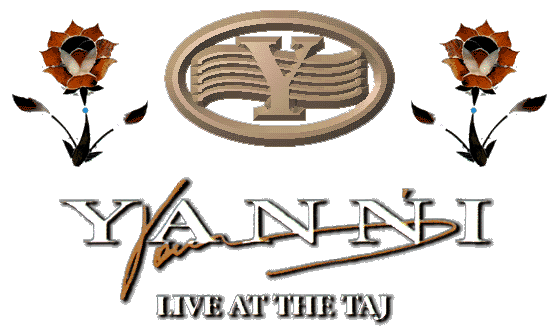


The Taj Mahal, located on the Yamuna River in the city of Agra, India, is a monumental Islamic edifice built by SHAH JAHAN, Mogul emperor of India (r. 1628-58). Designed as an extraordinary representation of the throne of God in paradise, the structure also served as a mausoleum for the emperor's beloved consort Arjunand Banu Begum, who was also known by the title Taj Mahal ("crown of the palace"). It is widely acknowledged to be the greatest masterpiece of Indian Mogul architecture and one of the world's most beautiful buildings.

Work on the Taj Mahal was begun shortly after Arjunand's death (1631) and was completed in 1648. The mausoleum itself, which rises about 57 m (187 ft) from a platform of roughly 29 sq m (313 sq ft), is a domed building laid out in perfect symmetry along four axes. The composition and proportions of the mausoleum, as well as its use of such elements as a double dome, a high portal, and corner domes, represent the culmination of a tradition of secular mausoleums that had originated centuries earlier in Iran and Central Asia and was developed further in Mogul India by the emperor Humayun (r. 1530-56). The unique qualities of the Taj Mahal lie in the magnificent contrast between the white marble facade of the mausoleum and the red sandstone of the surrounding buildings, in the ethereal harmony of its parts, and in the rationally thought-out proportions between its fulls and voids.

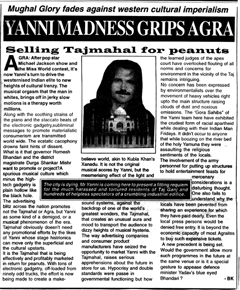 Its kind of an acrid, smokey undertone, reminescent of burning grass. No doubt caused by the widespread use of cow dung as fuel. The smell permeates everything, so after a day or so your nostrils give up and you don't notice it anymore.
Its kind of an acrid, smokey undertone, reminescent of burning grass. No doubt caused by the widespread use of cow dung as fuel. The smell permeates everything, so after a day or so your nostrils give up and you don't notice it anymore.
Waiting for us outside the airport was a crush of humanity. Kept at bay by a 30'x50' corral, there were bus drivers, taxidrivers, tour operators, and people willing to carry our luggage for a few rupees all densly packed against the outside of this corral, and we, standing there blinking and red eyed, on the inside. We located our bus driver and proceeded to the small opening in the corral where, flanked by airport security, we ran the gauntlet of helpful, beckoning would be porters and guides.
We were to overnite in Delhi before proceeding on to Agra. We stayed at the Meridian in Delhi, a five star hotel, very nice, I now have an ashtray from there.

The trip to Agra was made by bus. This might be a good time for a word or two about driving in India. Theoretically, Indians drive on the left, but practically, they drive mostly in the center, this way most of the larger potholes can be avoided.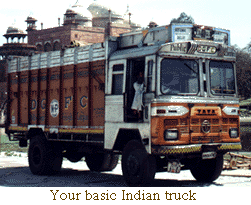 It is possible to drive in India with bald tires, no brakes, and burnt out headlights, but a working horn is absolutely required. The horn is used to pass slower vehicles, any slower vehicles, bicycles, mopeds, ox carts, whatever, and it is used constantly. Oh and larger vehicles rule, so when our bus and a truck, traveling in opposite directions, down the center of a two lane road, meet, well the effect is pretty harrowing. The only thing that could be worse would be doing it at night. Which we will be doing on the trip home.
It is possible to drive in India with bald tires, no brakes, and burnt out headlights, but a working horn is absolutely required. The horn is used to pass slower vehicles, any slower vehicles, bicycles, mopeds, ox carts, whatever, and it is used constantly. Oh and larger vehicles rule, so when our bus and a truck, traveling in opposite directions, down the center of a two lane road, meet, well the effect is pretty harrowing. The only thing that could be worse would be doing it at night. Which we will be doing on the trip home.
We did a little sightseeing in Delhi, Rock and Roll style, that is, out the bus windows, half asleep. Delhi was the colonial Capitol of India under British rule so the city is replete with colonial edifaces. The India arch and the Presidential Palace are a couple we caught a glimpse of before we headed out of town.
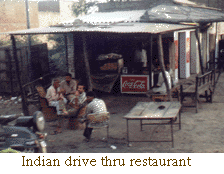 The Indian people are a very resourceful and opportunistic people. At every construction site along the road between Delhi and Agra, and there were quite a few, a little town would spring up. Shopkeepers would set up small 4'x4' shacks on legs, and from there the workers could get something to eat, get a shave, or get a bicycle repaired.
The Indian people are a very resourceful and opportunistic people. At every construction site along the road between Delhi and Agra, and there were quite a few, a little town would spring up. Shopkeepers would set up small 4'x4' shacks on legs, and from there the workers could get something to eat, get a shave, or get a bicycle repaired.
We stopped at a tourist rest stop where we were treated to the obligatory snake charmer featuring two cobras and a python, a guy with a camel you could have your picture taken on, and a dancing bear. Of course you could take pictures but you were expected to fork over a few rupees.

We arrived in Agra, City of the Taj Mahal, late in the afternoon. We could see the Taj, or at least the top of it, from the window at the end of the hall. Some of us were eager to explore, and we met at the lobby shortly after our arrival. Five of us, Matt, Dietrich, Bill, Paul, and I hailed a cab and headed for one of the bazaars in town. As soon as we got out of the cab we were immediately swamped with helpful bicycle rickshaw drivers. I can imagine what we looked like to them, five fat white Americans, dripping with rupees. The rickshaw drivers were very polite and not threatening at all, but they just wouldn't go away. We walked up the street, they would follow, we walked around the corner, they would follow, five of us, five of them, stuck to us like glue.
I can imagine what we looked like to them, five fat white Americans, dripping with rupees. The rickshaw drivers were very polite and not threatening at all, but they just wouldn't go away. We walked up the street, they would follow, we walked around the corner, they would follow, five of us, five of them, stuck to us like glue. 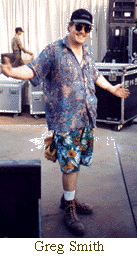 Finally I suggested we duck into a bar, after passing one several times. It had the advantage of being upstairs, somewhere the rickshaw drivers couldn't follow. Good move! The rooftop bar was cool and quiet, and the beer was cold and plentiful. Some kind of bellydancing troupe managed to follow us up there, but we ignored them as hard as we could, and they went away.
Finally I suggested we duck into a bar, after passing one several times. It had the advantage of being upstairs, somewhere the rickshaw drivers couldn't follow. Good move! The rooftop bar was cool and quiet, and the beer was cold and plentiful. Some kind of bellydancing troupe managed to follow us up there, but we ignored them as hard as we could, and they went away.
This is where we met Nadi. Nadi is an autorickshaw driver. We didn't know it at the time. We just thought he was a patron of the establishment. We asked him if he knew of a restaurant nearby. Suddenly all we could desire was only a short autorickshaw ride away. He offered to take us to the "only restaurant" We took him up on his offer after we figured out that he meant,"The Only Restaurant". Five of us crammed into Nadi's autorickshaw and set out. Do you have the visual?. We discovered it was located near our hotel and had an excellent Chinese and Indian menu. Nadi became our driver, guide, and cultural liason for the rest of the evening. After that we always had Nadi or one of his fleet of friends at our beck and call for an autorickshaw adventure.

Things got really busy once we showed up at the venue. The day the bulk of the lighting crew showed up on the site the scaffold guys had been there two weeks already,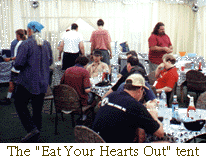 they indicated they were a week behind. Much of the scaffold was to be provided by Indian contractors and was "coming from Delhi". This became a familiar refrain, seemed like everything was, at one time or another "coming from Delhi". Our scaffold guys didn't just sit around and wait however. They had brought quite a bit of scaffold of thier own for the larger towers that the Indian company didn't feel comfortable providing, so our guys began erecting it in place of the Indian scaffold on either side of the stage and at the front of house mix position. We were faced with a stage, three towers, half erected, and a dress rehearsal in ten days.
they indicated they were a week behind. Much of the scaffold was to be provided by Indian contractors and was "coming from Delhi". This became a familiar refrain, seemed like everything was, at one time or another "coming from Delhi". Our scaffold guys didn't just sit around and wait however. They had brought quite a bit of scaffold of thier own for the larger towers that the Indian company didn't feel comfortable providing, so our guys began erecting it in place of the Indian scaffold on either side of the stage and at the front of house mix position. We were faced with a stage, three towers, half erected, and a dress rehearsal in ten days.

Seeing that the production manager was up in the steel, and being a man of action myself, always one to lead by example, I hit the steel. It was brutally hot. The Indian crew, the only ones with any sense, sought shade during the hottest part of the day, not us though, we baked. The American scaffold guys were so thankful to have another English speaker on thier crew. Greg Smith, the spotlight vendor, 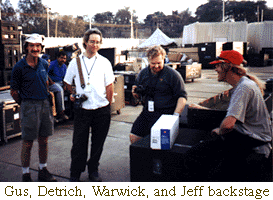 and Jeff from Xenotech were up there too, setting ledgers and hanging the frames for the lighting instruments.
and Jeff from Xenotech were up there too, setting ledgers and hanging the frames for the lighting instruments.
After three days of this we were showing significant progress.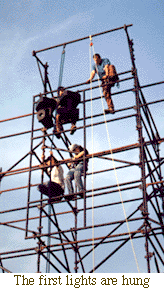 Most of the lights were hung and the front of house position was showing signs of completion. Even the Indian scaffold began to show up. The last piece of the puzzle, the transformers for Showpower, had been located at customs and were "coming from Delhi", and the first show was still six days away.
Most of the lights were hung and the front of house position was showing signs of completion. Even the Indian scaffold began to show up. The last piece of the puzzle, the transformers for Showpower, had been located at customs and were "coming from Delhi", and the first show was still six days away.
Things relaxed a little. Our autorickshaw driver, Nadi, started showing up in new sunglasses and new clothes. His rickshaw now sported new upholstery. Our local hangout, "The Kings Crown", a rooftop restaurant near the Taj, 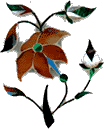 opened a new floor, dedicated in our honor. The economy of Agra certainly boomed while we there! We had time to visit the Taj, and do some shopping. I was fascinated by the marble inlay work in the Taj Mahal itself. Even though it was dark inside the thing, the closer you got to the tomb, the more intricate the inlay work becomes. I brought home plenty of souvenirs. The inlay work featured on this page is authentic, scanned from some of the marble handicrafts I brought home.
opened a new floor, dedicated in our honor. The economy of Agra certainly boomed while we there! We had time to visit the Taj, and do some shopping. I was fascinated by the marble inlay work in the Taj Mahal itself. Even though it was dark inside the thing, the closer you got to the tomb, the more intricate the inlay work becomes. I brought home plenty of souvenirs. The inlay work featured on this page is authentic, scanned from some of the marble handicrafts I brought home.

Seemed like the local newspapers never had anything nice to say,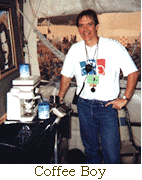 especially after one of the reporters got fired from his stagehand job with us, but there was always an article in every paper every day. Yanni is big news in India.
especially after one of the reporters got fired from his stagehand job with us, but there was always an article in every paper every day. Yanni is big news in India. 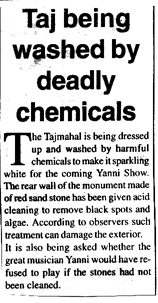
Once the lights were all hung some of us shifted over to the night shift. We had been in rehearsals for two weeks prior to leaving for India so most of the programming was done. All that remained was to incorporate the Taj, and some of the floor lighting into the cues. This meant long hours in the mosquito infested riverbed. Fortunately someone had the foresight to bring a lot of mosquito netting, the whole front of house mix position was encased in it. We also had the foresight to bring a coffee pot, a cappucino machine, a few cans of Trader Joe's Columbia Supremo, oh, and my favorite, ten bottles of premium Tequila, for medicinal purposes only of course!
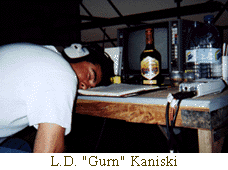
My job, when I wasn't focusing keylights or erecting scaffold, was self appointed coffee chef. We had the best cappucino in India I can assure you, even though I had to use powdered milk. We saw quite a few sunrises there on the riverbank. Seeing the Taj Mahal in the early glow of dawn was worth the trip all by itself.

While we slept, the day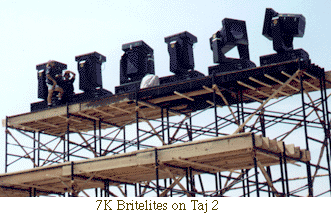 crew finished erecting "Taj 1 & 2", the towers containing the 7000 watt xenon lamps that would light the Taj itself.
crew finished erecting "Taj 1 & 2", the towers containing the 7000 watt xenon lamps that would light the Taj itself. 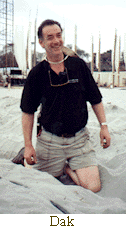 This proved to be a bigger job than anybody thought. The towers were supposed to be 60' tall, but the crane that was supposed to lift the lamps to the top only reached 30'. Time for some quick redesigning. Once the 24' towers were built the problem was getting the crane to them. First they had to build a road! The river bottom we were playing on was basically sand. Large 1/2" thick steel plates were delivered by camel or ox cart to the site and spread around to make roads and the backstage area. Once these plates were in place the Indian crew was very reluctant to move them. Our crew chief Dak Harris had to move mountains to get the road built to "Taj 1". Each plate took 16 Indian stagehands to move.
This proved to be a bigger job than anybody thought. The towers were supposed to be 60' tall, but the crane that was supposed to lift the lamps to the top only reached 30'. Time for some quick redesigning. Once the 24' towers were built the problem was getting the crane to them. First they had to build a road! The river bottom we were playing on was basically sand. Large 1/2" thick steel plates were delivered by camel or ox cart to the site and spread around to make roads and the backstage area. Once these plates were in place the Indian crew was very reluctant to move them. Our crew chief Dak Harris had to move mountains to get the road built to "Taj 1". Each plate took 16 Indian stagehands to move.
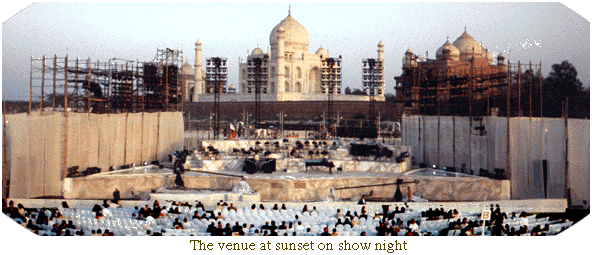
Keep in mind the the Taj Mahal had never been illuminated before in its 300 yr. history. What we were doing was a big deal. The first night we hit the Taj with those Xenons we could hear the oohs and aahs coming all the way from downtown Agra. The guys at the Kings Crown said the backlight effects were incredible. The very next day, postcards of the illuminated Taj were available in the hotel giftshop, and the the hotel's rooftop restaurant began advertising, "Best view of the illuminated Taj!"
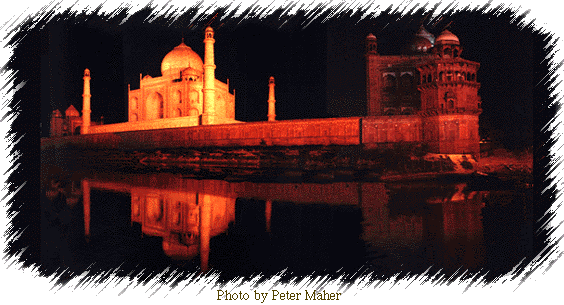

If you want , you can E-Mail me.
Yanni World Video Tour Lighting Crew
| Lee Rose | Lighting Designer |
| David "Gurn" Kaniski | Lighting Director |
| Paul Lennon | Assistant Lighting Designer |
| Stephen "Dak" Harris | Lighting Crew Chief |
| Jeff Durling | Gaffer |
| Warwick Price | Icon Operator |
| Dietrich Jungling | Status Cue Operator |
| Matt Firestone | Varilite Operator |
| Matt Croft | Varilite Technician |
| Gus Thompson | Yanni Lighting Technician |
| Tiffany Mclane | Yanni Lighting Technician |
| Greg Smith | Followspot Technician |
| Jeff Wilson | Xenotech Britelite Technician |
| Dave Laranaga | Xenotech Britelite Technician |
| Simon Carus-Wilson | Icon Technician |
| Lee Richardson | Master Electrician |
| Joseph Gonzales | Icon Technician |
| Jonathan Wood | Varilite-Garganturam Technician |
| Peter Radice | Varilite Lead Technician |
| Ian "Dobbo" Dobson | L.S.D. Lead Technician |
| Tom McGlinch | L.S.D. Technician |
| Bill Cherrington | L.S.D. Technician, Mayor of Agra |
Many thanks to all of you for making this a successful event!
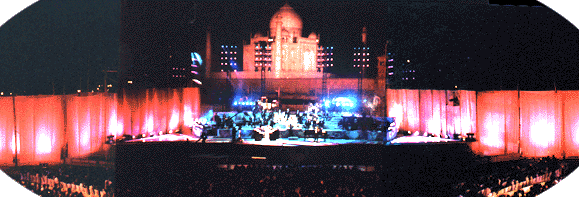

![]()